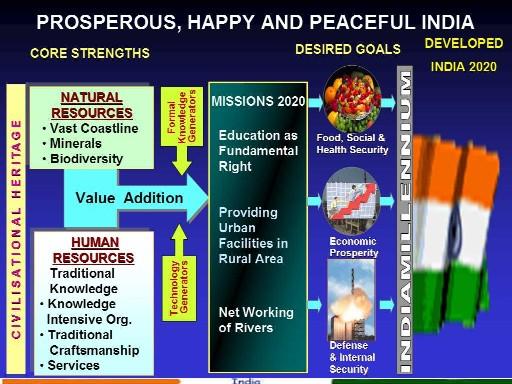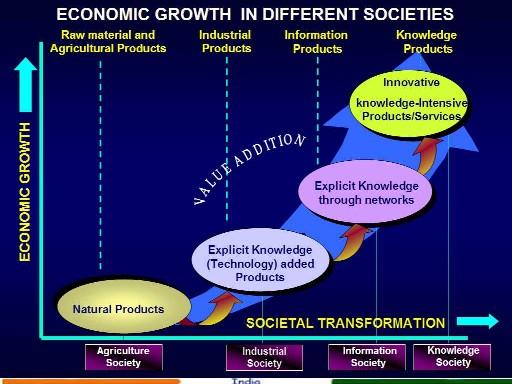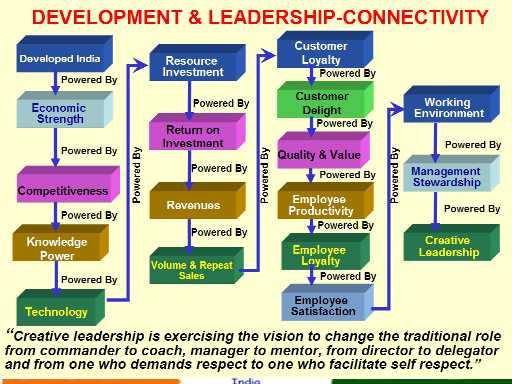Address at the Standing Conference of Public Enterprises
Vigyan Bhavan, New Delhi : 05-04-2003
Innovation drives Competitiveness
I am indeed delighted to participate in the Conference of Chief Executives of Public Sector Enterprises organized by the SCOPE, an apex organization of Public Enterprises and Department of Public Enterprises. I greet all the participants of this conference and the distinguished gathering. I would like to share certain aspects on 'Thinking Competitiveness in an integrated way of Technology - Manufacturing - Value Addition - Marketing.' The nation has declared that India should get transformed into a developed nation by 2020. That means : 260 million people below poverty line should be lifted up and prosperity propels the nation. Five areas have been identified. They are (1) Agriculture and food processing (2) Reliable and quality electric power for all parts of the country (3) Education and healthcare (4) Information and Communication Technology (5) Strategic sectors. Integrated development of these five areas will result in doubling the GDP growth rate to 9%.
Friends, industries have a very important mission in transforming India into a developed nation. While the industries taking cognisance of increasing productivity through technological interventions are making good strides, they have an equally important role in enriching our economy through harnessing traditional knowledge base and also the rural habitat building for prosperity. We believe there is a strong connectivity between these two approaches discussed. It must also be emphasised that success of these approaches is also dependent to a great extent on the recognition of industrial relevance in the educational system.
Did you listen to the national anthem in the beginning of this program? What did we observe? The best artistes of our nation were giving their best symbiotically converging with each other. I was moved; we were moved and the whole nation moved. Can we give the best in our field, like them? If we, the billion people, give our best in each one's task, no one on this planet can stop India from achieving its developed nation status - with economic prosperity, peace and happiness - a state that will make every Indian sing the song of India. What are our core competencies?
Core Strengths of India
The nation's strengths predominantly reside in its natural and human resources. In natural resources, India is endowed with a vast coast-line with marine resources and also oil wealth. In minerals, apart from conventional material resources, it is well-known that India has the largest deposits of titanium, beryllium and tungsten. India ranks among the top few nations having a rich bio-diversity. Knowledge-based value addition for these natural resources would mean exporting value-added products rather than merely the raw materials. Use of IT for commercialisation and marketing can increase our outreach and speed enormously. Ancient knowledge is a unique resource of India for it has the treasure of a minimum of 5000 years of civilisation. It is essential to leverage this wealth for national well being as well as to seek global presence for the nation. Civilisation that does not have the knowledge of technology or the technological nations without experience of civilization, cannot innovate newer economy.
Human resources, particularly with large young population, are unique core strength of the nation. This resource can be transformed through various educational and training programmes. Skilled, unskilled and creative manpower can be transformed into wealth generators particularly in the service sectors, agro industries etc. Knowledge-intensive industries can be generated out of our existing industries by injecting demand for high-level software/hardware, which would bring tremendous value addition. It is said, "the precious asset for a company or a country is the skill, ingenuity and imagination of its people. With globalisation, this will become more important because everybody will have access to world class technology and the key distinguishing feature will be the ability of people in different countries to use their imagination to make the best use of the technology". Let us see how the economy has grown in different societies and the main driving factors behind them.
Economic Growth in different societies
During the last century, the world has undergone a change from agriculture society, where manual labour was the critical factor, to industrial society where the management of technology, capital and labour provided the competitive advantage. Then the information era was born in the last decade, where connectivity and software products are driving the economy of a few nations. In the 21st century, a new society is emerging where knowledge is the primary production resource instead of capital and labour. Efficient utilisation of this existing knowledge can create comprehensive wealth of the nation and also improve the quality of life - in the form of better health, education, infrastructure and other social indicators. Ability to create and maintain the knowledge infrastructure, develop knowledge workers and enhance their productivity through creation, growth and exploitation of new knowledge will be the key factors in deciding the prosperity of this Knowledge Society. Whether a nation has arrived at a stage of knowledge society is judged by the way the country effectively deals with knowledge creation and knowledge deployment in all sectors like IT, Industries, Agriculture, Health Care etc., Indeed development and innovative use of multiple technologies with mission projects and transparent management structure will give thrust for transforming India into a 'developed nation'
Change in employment pattern, agriculture, industry and service - knowledge industries
In 1960, agriculture areas employed in parts or in full 74% of people of the country and it reduced to 62% in 1992 and expected to further fall to 50% of people in agriculture by 2010. Whereas, the demand of agricultural products will double in quantity. Productivity using technology and post harvest management will have to compensate the manpower reduction in farming and agricultural products sector.
In the case of industry, in 1960, 11% of the population was employed in small scale and large scale industries. The trend continued with 11% even during 1992. However, it has to increase by 25% in 2010, as the GDP growth with high technology in the situation of opening up of the economy under WTO regime. The pattern of employment will take a new shape. Service with knowledge industry component from 15% employability in 1960 has increased to 27% in 1992. Based on the current trend it will further increase to 50% in this decade in view of infrastructure maintenance areas, financial sector, IT sector and entertainment demands. This big change will demand in all areas more trained skilled human power and technology personnel. Our industrialists, commercial chiefs and technologists may have to get ready for such transformation in agriculture, industries and service - knowledge industries for which human power with knowledge, innovation and skills has to be evolved in a mission mode.
Building innovation systems
It is through the process of innovation that knowledge is converted into wealth and social good. Further, innovation is an important factor for the competitiveness of both service and manufacturing sectors. Innovation tends to emanate from R&D and many more from other sources, including organizational change. Hence there is an urgent need to establish an environment for growth of efficient innovation system in the country. Such a system would involve creation of clusters, which are networks of inter-dependent firms, knowledge producing institutions (universities, colleges/institutes, research institutes, technology providing firms), bridging institutions (e.g. think tanks, providers of technical or consultancy services) and customers linked in a value-addition creating production chain. The concept of clusters goes beyond that of a firm network, as it captures all forms of knowledge sharing and exchange. Thus an innovative system with its clusters would tap into the growing stock of global knowledge, assimilate and adapt it to local needs and finally create new knowledge and technology. For such an innovative system to succeed, the following are necessary: (a) improving inter-ministerial coordination and ensure consistency and credibility in policy formulation; and (b) introducing new mechanisms to support innovation and technology diffusion, including greater use of public/private partnership.
Competitiveness and innovation
I see wonderful roads and flyovers being built- very fast - much speedier than ever before in India. If we look at those new equipment used, very few are from India. Same thing about computers: most manufactured parts are imported and assembled. Go to hospitals: look at the equipments. Very few are manufactured in India. Go to biotechnology laboratories. Very few equipments and instruments are manufactured in India. The list is long?. The industrial growth in GDP is crawling upwards. The IT services are good but with a nation of a billion people, we have to necessarily give thrust to agriculture and importantly value adding modern manufacturing.
When Nehru talked of "Commanding heights" of public sector, he also emphasised the fact that future belongs to only those who make friends with science and technology. I see a lot of data on cumulative investments on PSEs by Govt and the cumulative internal returns etc. Very impressive. It is essential to have such an indicator company-wise, PSE-wise on the accumulated capabilities in technologies. A number of new products and processes have been created. A number of technologies generated and exploited as products or technology transfers? Even these two simple indicators will show how the PSE or a Private Company has been able to handle technology for performance in the market place, with the users and consumer. That is the essence of TECHNOLOGY FOR COMPETITIVENESS.
The indices of world competitiveness are based on the global competitiveness report prepared by the World Economic Forum. The forum has defined competitiveness as "the ability of a national economy to achieve sustained high rates of economic growth". As per this definition ranking of different countries as of April 2001, according to the forum, are: USA[1], Singapore[2], Hong Kong[6], Australia[11], Taiwan[18], China[33] and India[41]. The world competitiveness is therefore decided by a triangular combination consisting of progressiveness of industry, technology push and status of governmental deregulation, all working in unison. Technology-led industrial growth can be sustained only through establishing an innovation system. It is through the process of innovation that knowledge is converted into wealth. Further, innovation is an important factor for the competitiveness of both service and manufacturing sectors and hence the urgent need to put in place an innovation system. Such a system would involve network of firms, knowledge-producing institutions, bridging institutions and customers/users in a value addition-creating production chain. With such a consortium, the innovation system would tap into the growing stock of global knowledge, assimilate and adapt it to local needs and finally create new knowledge and technology. India must evolve such systems to improve its competitiveness in a global marketplace. Competitiveness emerges from the strength of knowledge power, which is powered by technology that in turn is powered by capital. In the coming years, competitiveness would be derived from the ability to recognize and integrate all forms of knowledge leading to innovation in every area of human endeavour.
Creative Leadership
For building the developed India, what are the essential needs? We have natural resources and we have human power. There are 700 million people below 35 years in the population of a billion people. The nation needs young leaders who can command the change for transformation of India into a developed nation embedded with knowledge society from now to 2020. The leaders are the creators of new organizations of excellence. Quality leaders are like magnets that will attract the best of persons to build the team for the organization and give inspiring leadership even during failures of missions as they are not afraid of risks. I have seen and worked with creators of vision and missions. The vision ignites particularly the young mind.
One of the very important ingredients for success of the vision of transforming India into a developed nation by 2020 is the evolution of creative leaders. We can see a connectivity between developed India, economic prosperity, technology, production, productivity, employee role and management quality, all of which linked to the creative leader. Who is that creative leader? What are the qualities of a creative leader? The creative leadership is exercising the task to change the traditional role from commander to coach, manager to mentor, from director to delegator and from one who demands respect to one who facilitate self respect. The higher the proportion of creative leaders in a nation, the higher the potential of success of visions like "developed India."
Concluding remarks
We are all aware of the historic role played by the PSEs in the post-independence era of nation-building. We have drawn our economic and industrial strength from the shop floors of these PSEs. But we all have to change. Change is the only constant in life - the sooner we realize this the better it is. There is no point in only dwelling on the past glories of the sector. We have to look at the future and see what it has in store for us. All of us must see the bend in the road otherwise we are bound to lose our way. We cannot undo the past. These are changing times and we must change with them for the present and future demands and act with speed. In India, the present trend is that many of our big industrial complexes are becoming red for the reasons of absence of timely technology upgradation and not realizing the change needed in business dynamics. I am sure your deliberations from this Conference of Chief Executives will definitely study this situation and suggest pro-active measures for resurrection wherever it is needed. Indian industries have to have multiple business markets in civil and defence markets within the country and abroad. Particularly export business is based on the dynamics of the politics, drought, flood and many other problems of that nation. The management style of PSEs need to change as a function of typical high performance industry. The boundary conditions need to be extended as much as possible.
I would like to request that Indian Industries (PSEs & Private Sector) should learn to think big with the whole world as our market by developing a strong and interactive Technology- Market - Value Adding Competitive Linkage. Then we can all sing the song of India. It will be a great resurgence for our manufacturing, marketing, and maintenance Services. Indian Industries should aim to become multi-national. Our youth love challenging jobs. We have to create challenging opportunities for them. We can WIN if we think we can win and act tenaciously with our clear goals in India to EXCEL IN A COMPETITIVE NEW WORLD AND CREATE INDIA BRAND.
My best wishes to all of you.



